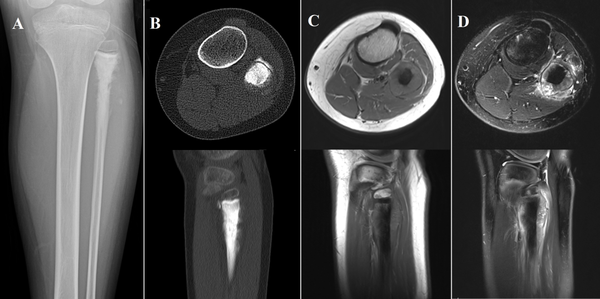-
Home
-
About JCTR
-
Gold Open Access
-
Issues
-
Editorial board
-
Author guidelines
-
Publication fees
-
Online first
-
Special issues
-
News
-
Publication ethics
-
Partners
-
Submit your manuscript
-
Submit your review report
-
Editorial Office
-

This work is licensed under a Creative Commons Attribution-NonCommercial 4.0 International License. ISSN print: 2382-6533 ISSN online: 2424-810X
Volume 7 Issue 1
A small-cohort study on tumor recurrence and surgery-related complications associated with proximal fibular tumors and the potential utility of biopsy
Tao Sun#*, Michal Heger#, Lingxiang Wang, Mengjing Niu, Shuman Han, Xiaoran Zhang, Haitao Zhao, Wenjuan Wu
Sun et al. J Clin Transl Res, 2021; 7(1):14
Published online: February 25, 2021
Abstract
Aim. To assess the incidence of tumor recurrence, iatrogenic peroneal never injury, and wound healing problems in a small cohort of patients with proximal fibular tumors who had undergone surgery and to determine the relative risk of pre-operative biopsies on these outcome variables.
Methods. The study entailed a retrospective single-center analysis of patients with a histologically confirmed tumor in the proximal fibula who had undergone surgery at our institution between 2004 and 2019 (N = 66). The accuracy of diagnosis based on pre-operative biopsy (N = 10) was compared to the histological diagnosis based on resection specimens. The association between pre-operative biopsy and patient demographics and medical history as well as tumor recurrence, iatrogenic peroneal nerve injury, and impaired wound healing were analyzed statistically. The data were presented against a backdrop of bone cancer incidence and 5-year survival rates in China.
Results. Recurrence, iatrogenic peroneal nerve, and wound healing issues were identified in 5 (7.6%), 8 (12.1%), and 6 patients (11.0%), respectively. A biopsy was acquired from 10 of 66 patients. The pre-operative biopsy diagnostic accuracy rate was 100%. Males had an 11.2-fold higher risk of undergoing pre-operative biopsy than females (95% CI, 1.3-94.1; P = 0.013). Pre-operative biopsies were 11.2 times more likely to be obtained from patients with malignant and benign aggressive tumors in the proximal fibula compared to benign tumors (95% CI, 1.1-63.1; P = 0.013). Patients who had undergone biopsy were 12.4 times more likely to receive type I or type II en bloc resection (95% CI, 1.5-104.3; P = 0.006) and had a 7.6-fold greater chance to have impaired wound healing (95% CI, 1.3-45.1; P = 0.040), which was observed mainly in osteosarcoma patients. There were no significant associations of biopsy with tumor recurrence (P = 0.162) and iatrogenic peroneal nerve injury (P = 0.095).
Conclusions. Biopsy of proximal fibular lesions does not increase the risk for tumor recurrence and iatrogenic peroneal nerve injury but may be associated with post-surgical wound healing. This is particularly relevant for male patients and malignant and aggressive benign lesions, where biopsies are considerably more likely to be acquired to guide diagnosis and clinical management. Readers should note that, due to the relatively low incidence of this cancer type and the scarcity of pre-operative biopsies, larger cohort studies are warranted to validate the results.
Relevance for patients. Patients who present with proximal fibular tumors are often young. Depending on the diagnosis of the bone cancer subtype, the surgical intervention may entail highly invasive and risky procedures. Taken together, it is imperative to ensure accurate diagnosis of the bone cancer subtype to prevent unnecessary procedures. Diagnostic accuracy can be increased by acquiring a histological specimen of the malignant bone tissue. However, it is currently not completely established whether bone biopsies in the proximal fibula can be safely performed and whether such biopsies lead to seeding metastases. Because of the rarity of these tumors and procedures, studies are needed even when these entail a small sample size.

DOI: http://dx.doi.org/10.18053/jctres.07.202101.014
Author affiliation
1. Department of Orthopedic Surgery, Third Hospital of Hebei Medical University, Shijiazhuang, Hebei Province 050051, PR China
2. Department of Pharmaceutics, Jiaxing Key Laboratory for Photonanomedicine and Experimental Therapeutics, College of Medicine, Jiaxing University, Jiaxing, Zhejiang, PR China
3. Laboratory Experimental Oncology, Department of Pathology, Erasmus MC, Rotterdam, the Netherlands
4. Department of Gynecology, Fourth Hospital of Hebei Medical University, Shijiazhuang, Hebei Province 050011, PR China
5. Department of Radiology, Third Hospital of Hebei Medical University, Shijiazhuang, Hebei Province 050051, PR China
#Equal contributors
*Corresponding author
Tao Sun
Department of Orthopaedic Surgery, Third Hospital of Hebei Medical University, 139 Ziqiang Road, Shijiazhuang 050051, Hebei Province, China.
Tel: +86-0311-88602568
Fax: +86-311-87023626
E-mail: doctorsun@139.com
Handling editor:
Rowan van Golen
Academic Medical Centre, University of Amsterdam
Department of Surgery, Surgical Laboratory, Amsterdam, Netherlands

